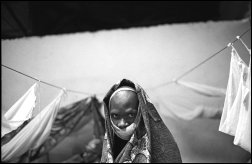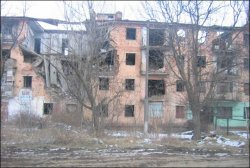Skip to: Democratic Republic of Congo | Chechnya | Haiti | R&D For HIV/AIDS | Northeastern India | Southern Sudan | Somalia | Colombia | Northern Uganda | Ivory Coast
Congolese Ravaged by War and Disease
The extreme deprivation and violence endured by millions of Congolese goes virtually unnoticed to the rest of the world. Since mid-November, renewed fighting between the Congolese Army (FARDC) and the Mai-Mai rebels has caused the displacement of tens of thousands of people throughout Katanga province, in southeast Democratic Republic of Congo (DRC). In one instance in early December, armed men attacked a camp for displaced people in Katanga, forcing some 3,000 people to once again flee for their lives. This spate of violence is just the most recent endured by people in the DRC. More than a decade of war and devastation has collapsed an already weak public health system and caused widespread misery for people throughout the country. During the past year, the northeastern regions of Ituri, North Kivu, and South Kivu were again the epicenter of violence, with multiple factions fighting for the control of the area's resources, preying on civilians, and committing appalling sexual violence against women. Between January and May, MSF assisted many of the 80,000 civilians who had fled their homes in Ituri because of fear and insecurity. Emergency relief programs in the DRC represent MSF's largest mobilization of aid in the world today, and recent MSF surveys found staggeringly high child mortality rates in several regions — more than six times the emergency threshold in the violence-plagued town of Lubutu and more than five times in the relatively stable town of Inongo. The surveys also revealed that few people have access to health facilities let alone treatment, even in areas not ravaged by violence, in part because they cannot afford the fees, leading to an even greater human toll taken by easily treated diseases like malaria and cholera. While the war officially ended in 2003, peacekeeping and political efforts have not translated into better living conditions for most Congolese and the situation remains dire in many parts of the country.

Staggering Needs, Insecurity, and Dismal Response for Chechens Living in Fear
Caught in a stranglehold between Russian Federation forces and Chechen armed groups, traumatized civilians continue to bear the brunt of this conflict of attrition and find they have nowhere to go to be safe. Driven back to Chechnya out of tented camps in Ingushetia, thousands of reluctant civilians returned to their devastated homes only to find what they had fled: fear, violence, and an ever-growing feeling of isolation. Officials claim that the situation in Chechnya has "normalized", but so-called sweep operations to round up suspected rebels, landmine accidents, disappearances and violence perpetrated by local militias are all too common. With a limited international aid presence because of the insecurity, MSF has found ways to support health structures, surgical programs, and start assistance projects in several regions of Chechnya with Chechen staff. At the MSF-supported Hospital Number Nine in Grozny, the largest trauma center in Chechnya, staff treated hundreds of patients for violent trauma last year, including many gunshot and land-mine victims. Many Chechens who have returned live precariously as internally displaced because their homes were destroyed or their towns are still insecure. The living conditions for the tens of thousands of Chechens remaining in Ingushetia vary from difficult to unbearable, with many inhabiting overcrowded, dank, dilapidated buildings that enable diseases like tuberculosis (TB) and pneumonia to flourish. "Recently, it is the absolute sense of despair and hopelessness which is proving hardest to treat," said an MSF nurse in Ingushetia — herself displaced from Chechnya. While insecurity persists in the entire region, there is an extremely limited international aid response and the Chechen conflict has all but disappeared from the international political agenda.

Haiti's Capital Wracked by Waves of Violence
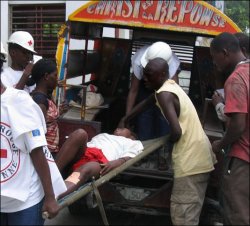
Haitian red cross workers rush a gunshot victim to the MSF trauma center in Port-au-Prince. MSF's 56-bed trauma center at St. Joseph's is the only hospital that provides free, high quality emergency medical and surgical care for the many victims of violence. 2005 © Kevin Phelan/MSF
Many people in Haiti's capital, Port-au-Prince, are trapped by the widespread violence that has hit the city in waves since President Jean-Bertrand Aristide was pressured into exile in February 2004. People have been shot and killed, deliberately and unintentionally, by all of the armed factions fighting in the seaside slums, or "quartiers populaires," and the violence — both politically motivated and criminal — is spreading throughout the city. MSF treated more than 2,250 people for violence-related injuries in 2005 at a trauma center set up in the capital, including nearly 1,500 gunshot victims. Half of those treated are women, children or the elderly, underscoring the toll the violence has taken on civilians. Appalled by the deteriorating security situation, in July MSF called on all armed groups to respect the safety of civilians and to allow the wounded to access emergency medical care. The following day, however, the trauma center received 27 gunshot victims — three-quarters of them women and children — who were wounded during a day-long military operation launched by the UN Stabilization Mission in Haiti (MINUSTAH) in Cité Soleil, the most violent part of the capital. In August, MSF reopened Choscal Hospital and the Chapi Health Center in the heart of Cité Soleil, where 250,000 people live in abject poverty and were effectively excluded from any health care. In just three months, MSF performed nearly 12,000 medical consultations and treated more than 800 patients needing emergency care. "Civilians in many parts of Port-au-Prince are struggling just to survive," said Ali Besnaci, head of mission for MSF in Haiti. "Every day, people throughout the city tell us that they have never experienced such levels of violence before."

No R&D for HIV/AIDS Tools Adapted to Impoverished Settings
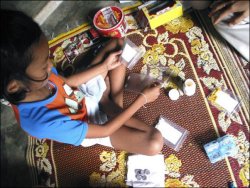
An 11-year-old girl living with HIV/AIDS prepares her antiretroviral medicines. She and her mother received treatment adherence counseling from an MSF home-based care team operating in Prachomklao province, Thailand. 2004 © Joanne Wong/MSF
The overall picture is well-known. More than 40 million people worldwide have HIV/AIDS, and every day, 8,000 people die of AIDS-related illnesses — 1,400 of them children. While the HIV/AIDS pandemic receives regular media coverage, almost no attention is paid to the near-total lack of research and development (R&D) into new tools specifically adapted for patients most affected by the AIDS crisis: those living in poverty in the developing world. Diagnosing HIV infection in infants, for example, currently requires extremely resource-intensive technology, so few HIV-positive infants can initiate life-prolonging treatment and half die before their second birthday. Even if children are diagnosed in time, there are no pediatric versions of easy-to-take antiretroviral (ARV) combinations like those that exist for adults. Slowing the pandemic's toll will also require substantial investment into diagnostic tests that identify tuberculosis (TB) infection — the leading cause of death among people living with HIV/AIDS. The current sputum-based test is more than 100 years old and fails to detect TB in HIV-AIDS co-infected patients. Tools are also needed to help clinicians recognize when current ARV treatments are failing so patients can be switched to more effective drug regimens, and there's a dire need for patient-friendly combinations of second-line drugs so patients are not faced with an increased pill burden when changing treatment regimens. Without such R&D into new HIV/AIDS diagnostics and medicines adapted to the realities of people in impoverished areas the HIV/AIDS catastrophe could, astonishingly, become even more devastating.

Clashes in Northeastern India Take a Heavy Toll on Civilians
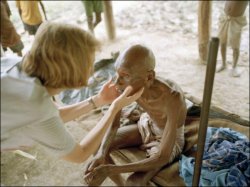
MSF-run clinics in four camps for internally displaced people provides basic health care and malaria treatment in the Kokrajhar district of northeastern India's Assam state. © Tom Craig
Civilians in India's northeastern Assam and Manipur states continue to be affected by recurring outbreaks of political violence along religious and ethnic lines, as well as by long-lasting conflicts between the Indian government and militant groups. More than 90 people were massacred in Assam's Karbi Anglong district during the latest outburst of violence and retaliatory killings in October 2005. The clashes — all too common in India's northeast — drove an estimated 40,000 people from their homes in Karbi Anglong and nearby North Cachar district to seek safety in nearby hills. Over the last five years, more than 150,000 people have fled their homes in the region because of such violence. Without food, shelter, and other resources, the displaced often have no choice but to gather in overcrowded camps set up by the state government, where the general lack of provisions has led to outbreaks of measles, diarrhea and other illnesses. Authorities have kept thousands of people in deplorable conditions in such camps for more than eight years. In Goiramari, the displaced became so desperate that they threatened to hunger strike. Government neglect, terror from armed groups, and grinding poverty have also wrecked the region's existing health care system. Malaria has inflicted a terrible burden and few people have access to effective treatment, and MSF expects to treat as many as 50,000 people in Assam for malaria alone in 2006. The dire state of health care is also reflected in the mounting toll taken by HIV/AIDS and the growing number of people living with tuberculosis (TB) in Manipur. Despite the existence of treatment for both diseases, the vast majority of civilians caught up in the conflict zone cannot get the medical care they need.

War is Officially Over, But Urgent Needs Go Unmet in Southern Sudan
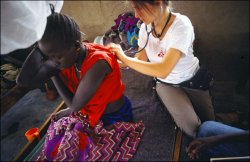
An MSF physician listens to the breathing of a patient receiving treatment for the disease kala azar at an MSF clinic in the village of Walgak in Sudan's Upper Nile region. 2004 © Tomas Van Houtryve
When the government of Sudan and the southern Sudan People's Liberation Army (SPLA) signed a peace agreement in January 2005, Africa's longest-running civil war officially came to an end. But hope — as well as media attention — was short-lived. One year later, those most affected by the twenty-year conflict have yet to witness any real improvement in their abysmal living conditions. Recurrent medical emergencies, sporadic fighting (most alarmingly in Upper Nile and Western Equatoria), and a potential massive return of people to areas with little or no access to care means that many people will depend on humanitarian aid for some time to come. The near-total lack of infrastructure means that even basic health care is beyond the reach of most, leading to a heavy burden from vaccine-preventable diseases like measles and treatable endemic diseases like malaria and tuberculosis (TB). Many patients walk for days to Akuem, Bahr-El-Ghazal in order to reach MSF's hospital — one of the only functioning hospitals in the entire province. MSF also provides treatment for kala azar in Upper Nile and for sleeping sickness in Western Equatoria. And with 6 million people largely relying on food assistance, it takes little for families to fall into an acute nutritional crisis. In 2005, failed rains combined with the return of tens of thousands of displaced people and refugees from neighboring countries, aggravated the region's chronic food insecurity. Throughout the year, MSF treated thousands of children for severe malnutrition in Upper Nile, Jonglei, and Bahr el Ghazal, while little has been prepared for the hundreds of thousands of people expected to return to southern Sudan this year. This may only worsen the dire situation faced by people in a region where resources are stretched thin and the infrastructure lays in ruins.

Somalis Endure Continuing Conflict and Deprivation
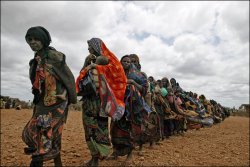
Every month, hundreds of mothers bring their children to be screened for malnutrition by MSF medical teams in the small village of Istorte in Somalia's Bakool region. 2004 © Espen Rasmussen
Since 1991, Somalia has been a state without a functioning central government. Fourteen years of conflict has precipitated the collapse of public health structures and a total absence of health care services. In most parts of the country, clinics and hospitals have been looted or seriously damaged by armed groups, while the UN estimates that there are only 4 doctors and 28 nurses or midwives for every 100,000 people. Sometimes, people travel 500 miles just to reach one of the few existing health centers. The result of this situation has been catastrophic, with malnutrition, extreme poverty, and drought just some of the many scourges faced by Somalis. Last year's lack of rain — one of the worst droughts to hit the country in twelve years — may expose nearly 2 million people in the south to acute food shortages in the next six months. Few aid agencies, though, choose to work in Somalia because violence is so widespread and the country's clan structure so complex, yet with no state medical services, there is a desperate need for assistance. MSF has been working in the country since 1986, and provides emergency assistance in the worst-affected areas in south and central Somalia. In addition to primary health-care services, MSF teams perform surgery, treat tuberculosis (TB) and kala azar, and provide pediatric care and therapeutic feeding for severely malnourished children. But the assistance falls far short of what is needed, and thousands of Somalis continue to die in the shadows of this forgotten disaster.

Colombians Trapped by Violence and Fear
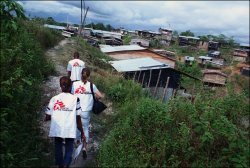
An MSF outreach team visits families in the shantytowns of Quibdo, Colombia, helping people to register with local authorities for free health care. 2004 © Pieter ten Hoopen/MOMENT
The situation for Colombians affected by the country's 40-year-old civil conflict did not improve in 2005. For decades, government military forces, paramilitary groups, and armed guerrillas have fought against the backdrop of the narcotics trade and conflict over natural resources, terrorizing and targeting civilians in both rural and urban areas. Violence continues to be the leading cause of death in the country and more than 3 million people have fled from their homes. Colombia now has the third highest number of internally displaced persons (IDPs) in the world, behind Sudan and the Democratic Republic of Congo, with many seeking safety and anonymity among the masses in shantytowns outside major cities where poverty, disease, and violence are rampant. Up to 62,000 people were displaced in the first part of 2005 alone — a 10 percent increase from the previous year. More recently, MSF teams in Cordoba and Norte de Santander brought emergency assistance to people affected by attacks and subsequent displacements. Armed groups involved on all sides exploit the displacement of civilians as a war strategy, while continuing violence against civilians throughout the country, including executions and kidnappings, causes multiple displacements and debilitating psychological anxiety. And even though the displaced are eligible for medical and social benefits from the Colombian government, fear and lack of information cause many to remain unregistered, thus without access to assistance. In an effort to alleviate some of the suffering, MSF provides essential medical services in Caqueta, Chocó, Cordoba, Sucre, Bolivar, Nariño, Norte de Santander, Tolima, Cundinamarca, and Bogotá, and runs mobile clinics to reach people in more remote parts of the country.

Insecurity Worsens Already Desperate Situation in Northern Uganda
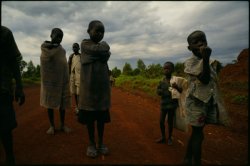
Every night, around 4,000 children leave their homes in the refugee camps near Gulu in northern Uganda out of fear that they will be abducted by members of the Lord's Resistance Army, and walk to the shelter operated by MSF. These children are commonly referred to as "night commuters." 2005 © Bruno Stevens/COSMOS
For nearly twenty years, people in northern Uganda have suffered from brutal conflict, including attacks by the Lord's Resistance Army (LRA) and forced displacements by the government. Today, more than 1.6 million people — nearly 80 percent of the population in the north — have been uprooted to camps that offer false security and hardly any assistance. While the death toll from direct violence continues to climb, many people die needlessly from preventable diseases like malaria, respiratory infections and diarrhea. Most of the displaced people in camps in towns like Gulu, Lira, Pader, Kitgum, Apac, and Katakwi are barely managing to survive in deplorable conditions, with chronic food and water shortages exacting a heavy price. As families struggle to survive the stress of war and displacement, poverty and high prevalence of diseases like HIV/AIDS also threaten to tear apart the entire social fabric. Violent ambushes on civilians and humanitarian aid workers in Kitgum and Pader districts in late 2005 only deepened peoples' fears and worsened the desperate situation faced by hundreds of thousands. The killings led MSF in November to call on all parties to the conflict to respect the safety of civilians and their freedom of movement as well as the independence and safety of humanitarian aid workers. MSF medical teams throughout the north continued to provide emergency relief, but warned that if the insecurity persisted, assistance to displaced people — woefully inadequate for years — could be reduced even further.

Crisis Deepening in Ivory Coast
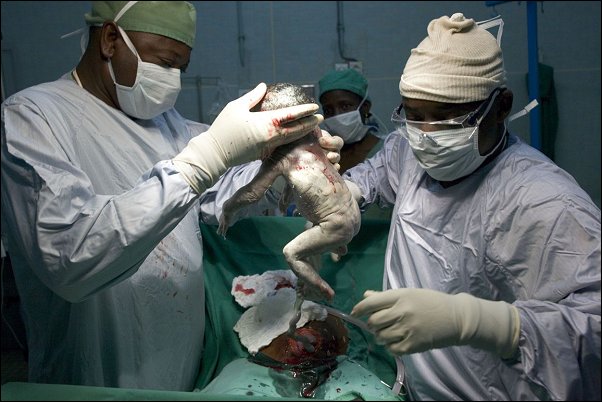
In the Ivory Coast's Bouake Hospital, MSF staff train a local surgical team to perform caesarean sections. MSF has been working in the hospital, located in the north, since a civil war erupted in the country in 2002. 2005 © Carl De Keyzer/Magnum Photos
The war that started in the Ivory Coast in 2002 has resulted in thousands of civilian deaths and forced hundreds of thousands of desperate residents to flee their homes. It has destroyed the livelihoods of many farmers, severely damaged the country's health-care system, and left many of the most vulnerable Ivorians without primary health care or sufficient food. Violence again broke out in November 2004 and February 2005, causing even more casualties and displacement. Civilians also face the constant threat of violence along the UN and French patrolled 1,200-mile line that divides the country's north and south. The recent formation of a transitional government offers some hope, but no immediate relief for the tens of thousands of people affected by treatable diseases like malaria and measles. There is no viable health system in much of the country. MSF operates medical programs on both sides of the frontline — often times as the only provider of free basic primary and secondary health care. At hospitals in Bouaké, Man, and Danané, and health centers and mobile clinics in Bangolo, Kouibly, Guiglo, and Bin Houin, MSF provides essential medical care including pediatric consultations, emergency medicine, obstetric and gynecological care as well as surgery. Mobile clinics in the west bring care to those living in more isolated areas. Malaria is a huge threat throughout the country, and MSF treated more than 70,000 cases in 2005. Family separations and the influx of soldiers have left many women and young girls vulnerable to sexual violence, prostitution, unwanted pregnancy, and sexually transmitted infections (STIs). MSF teams in western Ivory Coast have encountered high rates of STIs — just one of the many health problems Ivorians face — and started treatment of HIV/AIDS and TB alongside national authorities.

